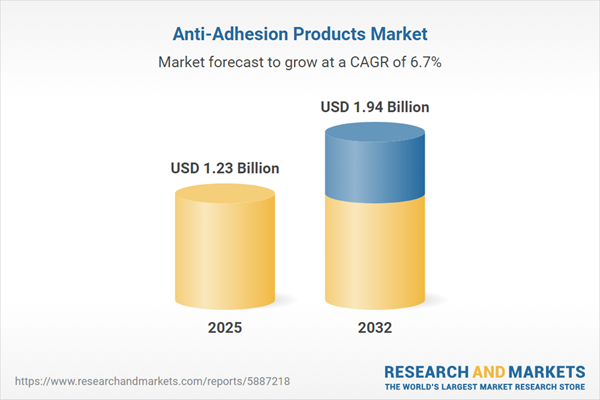Speak directly to the analyst to clarify any post sales queries you may have.
The anti-adhesion products market is evolving as healthcare organizations strive to enhance patient recovery, optimize operational efficiency, and leverage innovative procurement models. Senior decision-makers can benefit from new advancements that drive both clinical and operational improvements, positioning their organizations for sustained growth in a competitive environment.
Market Snapshot: Anti-Adhesion Products Market Dynamics and Growth
The anti-adhesion products market is expected to achieve robust and sustained growth through 2032, demonstrating ongoing demand for clinical solutions that address post-surgical adhesions. Rising surgical volumes and renewed clinical focus on successful patient outcomes are central to this trend. Hospitals and surgical centers are increasingly adopting innovations, including barrier membranes and targeted pharmaceutical formulations, that directly influence procurement strategies and in-theater usage. Continuous changes in regulatory guidelines, advances in product features, and competitive pressures are improving compliance, patient safety, and interdepartmental collaboration. As market participants adapt, the landscape increasingly prioritizes measurable improvements in clinical quality and operational excellence.
Scope & Segmentation
- Product Type: Combination anti-adhesion solutions incorporate barrier membranes with pharmaceutical agents to help prevent surgical adhesions while improving tissue regeneration. This segment includes key offerings such as heparin gel, hyaluronic acid-based agents, icodextrin-based compounds, and a diverse range of physical barrier products providing targeted post-surgical protection.
- Application: Anti-adhesion products deliver essential benefits in cardiovascular, gynecological, orthopedic, and general surgeries. Their adoption enables clinicians to tailor approaches according to procedural requirements, from standard operations to specialized interventions, supporting broad value across varied care environments.
- End User: Hospitals implement structured procurement and compliance frameworks, clinics favor agility and product responsiveness, and ambulatory centers apply standardized protocols to drive consistent uptake across multiple locations.
- Distribution Channel: Direct sales, pharmacy partnerships, and digital procurement technologies ensure timely product access and support efficient inventory management for healthcare providers responding to diverse clinical demands.
- Geographic Regions: Distinct regional trends shape adoption and procurement, influenced by regulatory frameworks, local sourcing policies, and differences in distribution infrastructure across the Americas, Europe, Middle East & Africa, and Asia-Pacific.
- Technologies: Hydrogel-based solutions and bioresorbable membranes deliver temporary anti-adhesion coverage in surgical settings. Advanced options such as heparin-enhanced gels target specific procedural outcomes, while digital monitoring systems facilitate the tracking of application and healing, supporting better patient recovery and report generation.
Key Takeaways for Senior Decision-Makers
- Multi-component anti-adhesion products enable hospitals to align clinical protocols with evolving safety requirements and the preferences of specialized teams.
- Embedding digital tracking systems into surgical and procurement processes enhances data transparency and cross-departmental coordination within large provider organizations.
- Close collaboration among manufacturers, suppliers, and distributors improves supply chain reliability and supports organizational responses to regulatory shifts.
- Sourcing and manufacturing strategies tailored to local conditions offer greater control over supply continuity, especially during regulatory or logistical changes.
- Expanding product lines permit rapid response to new procedural demands, ensuring access to targeted clinical options as standards develop.
- Investments in structured staff training programs encourage consistent deployment and optimal use of anti-adhesion products across varied clinical settings.
Tariff Impact: Navigating Cost Structures and Adoption Challenges
Recent changes in U.S. tariffs have driven manufacturers to focus on domestic sourcing and diversify supplier networks, leading to adjustments in anti-adhesion product supply chains. Healthcare organizations have responded by adopting centralized procurement and consolidated purchasing processes, which enhance inventory oversight and minimize vulnerabilities to supply disruptions. These adaptive strategies enable organizations to maintain consistent patient care and better manage the effects of regulatory changes throughout procurement cycles.
Methodology & Data Sources
This market analysis is based on a combination of secondary research, clinical trial review, and study of regulatory and financial records. Insight from surgeons, procurement leaders, and industry analysts ensures that the report addresses relevant adoption trends and evolving market dynamics.
Why This Report Matters
- Detailed segmentation helps leadership connect advances in anti-adhesion products with clear organizational priorities and practical operational needs.
- Supports decision-makers as they adapt procurement strategies and growth planning amid dynamic market trends and technology innovation.
- Gives healthcare organizations the tools to build clinical performance by integrating validated best practices and the latest anti-adhesion solutions.
Conclusion
Thorough segmentation analysis, targeted sourcing, and strong supplier partnerships position organizations to excel in the changing anti-adhesion products market, supporting improved clinical performance and operational outcomes.
Additional Product Information:
- Purchase of this report includes 1 year online access with quarterly updates.
- This report can be updated on request. Please contact our Customer Experience team using the Ask a Question widget on our website.
Table of Contents
3. Executive Summary
4. Market Overview
7. Cumulative Impact of Artificial Intelligence 2025
Companies Mentioned
The companies profiled in this Anti-Adhesion Products market report include:- Johnson & Johnson
- Baxter International Inc.
- Sanofi S.A.
- Integra LifeSciences Holdings Corporation
- CollPlant Holdings Ltd.
- Acell Inc.
- CGBio Inc.
Table Information
| Report Attribute | Details |
|---|---|
| No. of Pages | 195 |
| Published | October 2025 |
| Forecast Period | 2025 - 2032 |
| Estimated Market Value ( USD | $ 1.23 Billion |
| Forecasted Market Value ( USD | $ 1.94 Billion |
| Compound Annual Growth Rate | 6.6% |
| Regions Covered | Global |
| No. of Companies Mentioned | 8 |









